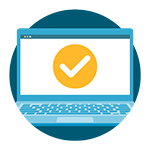Asset Finance
Purchasing new assets is part and parcel of running a business. From computers and office equipment to delivery vehicles and factory machinery, such items are often crucial to a company’s day-to-day operations and future growth.
However, there’s no escaping the fact that replacing or buying additional assets can come at a significant expense to small businesses. There’ll be many occasions when a company simply can’t afford to acquire an asset with a one-off payment. In such instances, they might look into asset financing.
What is asset finance?
An alternative to traditional bank loans, asset financing is designed to make purchasing assets more affordable for businesses. It lets companies spread the cost of an asset over several months or years - paying it off in small chunks rather than in a lump sum. This can allow a business to protect cash flow while continuing to invest in its growth.

Apply online


Get a decision


Receive your funds
What are the different types of business asset finance?
There are a few different types of asset financing and, as with any form of funding, they each have pros and cons. Finding the right asset finance solution will depend on a company’s specific needs and circumstances, but first it’s important to understand what the options are.
Hire purchase
Hire purchase is one of the most common forms of asset finance in the UK. Like when you buy a car “on finance”, it involves purchasing an asset and paying it off in instalments over an agreed term. At the end of the term, assuming all payments have been made, the business will have full ownership of the asset.
Advantages of hire purchase
Like most forms of asset financing, the main advantage of hire purchase is that it allows a company to spread the purchase cost over an extended period. Most lenders will offer some flexibility over the repayment term and initial deposit, if one is required, meaning a business can tailor a hire purchase agreement to their financial circumstances. There may even be a choice of fixed payments and seasonal repayments, which will vary depending on a company’s income at certain times of the year.
Another advantage of hire purchase is that the business will eventually own the asset, providing the option to sell it in the future. This can be a good way of unlocking capital for cash flow, acquiring additional assets or even part-funding the purchase of a replacement if the asset in question has become outdated. Assets can also be used to secure other forms of funding, such as business loans.
Disadvantages of hire purchase
Despite its advantages, there are a few downsides to hire purchase. Because most lenders charge interest on the monthly payments, a business will likely end up paying more for the asset than its cash price. VAT also tends to be payable upfront, as well as a deposit.
Additionally, hire purchase may not be the best option for companies that only need an asset for a short period. While there is flexibility over repayment terms, it can be more expensive to pay for an asset over a shorter term, which might make leasing a better option. Finally, the value of an asset usually depreciates with time, so it’s unlikely a business would be able to sell it at the same price – or higher – once it takes ownership.
Equipment leasing
Equipment leasing is different to hire purchase in that a business will rent but not own the asset, even at the end of the agreement. Instead, the equipment is usually returned to the lender. There are two main types of equipment leasing: operating leases and finance leases.
- An operating lease is where a business rents an asset in the short or medium term, without taking on the responsibility of extra costs such as maintenance fees. With an operating lease, the asset is usually rented for a small portion of its useful lifespan.
- A finance lease is where a business rents an asset for a longer period – usually for most of that asset’s useful lifespan. The company will also have to cover any maintenance costs but at the end of the agreement it could have the option to sell the asset and keep a share of the proceeds.
Advantages of equipment leasing
Equipment financing through a leasing agreement can offer plenty of benefits. It offers quick access to the assets and, if fixed monthly repayments are agreed, it can help businesses to budget with clarity.
The shorter-term nature of operating leases makes it easier to upgrade assets and equipment more regularly, and companies don't have to take on the added concern of carrying out maintenance and repairs. Additionally, this type of asset financing can offer some tax benefits - as the business does not own the asset, it won’t appear on its balance sheet.
Disadvantages of equipment leasing
There are some drawbacks to securing equipment or asset finance in this way. It can often work out more expensive than purchasing the asset outright and because it's essentially a rental agreement - a company will have no fixed asset to show for its outlay when the term comes to an end.
Some leases come with restrictions on how the asset can be used, which may not be suitable for the business. It can also be difficult to get out of an equipment lease without incurring significant penalties.
Asset refinancing
Asset refinancing is different to hire purchase or equipment leasing in that it involves assets that a business already owns. If a company needs to release some capital, it can sell the asset to a lender and then lease it back.
Advantages of asset refinancing
There are several advantages to this form of business asset finance. It frees up cash for a company to use as required – perhaps to acquire more stock or to support further growth. It also means the business can continue to use an asset that is crucial to its day-to-day operations.
Asset refinancing can also protect a company from the depreciation of the equipment’s value, while repayments are typically fixed and made via monthly instalments. This allows businesses to plan their future budgets more effectively.
Disadvantages of asset refinancing
One of the downsides to asset refinancing is that the amount of capital a company can release will depend on the value of the asset. There is also the risk that if the business fails to make its repayments, the lender could sell the asset to recoup its losses. Some lenders may also charge interest on the lease repayments.
The alternative to asset finance
Fleximize offers a convenient alternative to asset finance. With our fast, flexible business loans, your company can take immediate ownership of an asset and repay over a term of up to 60 months. There are no hidden fees or early-repayment penalties, and we’ll even recalculate the interest if you settle early, so you’ll only pay for the time you had the funding.
Here’s a summary of what we offer:
- Business loans of £10,000 – £500,000
- Flexible repayment terms of 3 – 60 months
- Approval and deposit in as little as 24 hours
- No hidden fees or early-repayment penalties
- Interest charged on a reducing balance, not the total loan amount
- Repayment holidays and top-ups available with all loans
- Exclusive discounts on industry-leading business services
We offer the Flexiloan and the Flexiloan Lite, so check out our services page and see which form of funding is most suited to you and your company. We understand the challenges that small businesses face, which is why we don’t apply the strict lending criteria of banks. Not only do we look for a way to say “yes” to every business, but we tailor our loans to suit the unique needs of each client.
Fill out our simple online form or call 020 7100 0110 to speak to a member of our friendly team about an alternative to asset finance.
How could this alternative to asset financing be used?
Hundreds of businesses have chosen Fleximize to fund an asset purchase, whether it’s a commercial printer or mash tun for a brewery. Here are just some of the assets you could buy using a loan from Fleximize:
Why choose Fleximize?
We're a multi-award-winning digital business lender dedicated to helping UK SMEs thrive. Here’s what you can expect when you come to Fleximize:
- Fuss-free funding: It takes just a few minutes to apply for finance online. You could get a decision, and even receive the funds, within 24 hours.
- Flexibility: We can find the funding to suit you, no matter your business or its needs. Our product features include repayment holidays, top-ups and our Penalty-Free Promise.
- Personal service: Your relationship manager will take the time to get to know you and your business. They’ll help you figure out which type of finance is going to work for you, and they’ll be your point of contact if you come back for more funding.
- Glowing recommendations: Our case studies and ‘excellent’ Trustpilot rating show why we’re held in such high regard by our customers.
- Award-winning products: We’ve twice been named Best Business Finance Provider at the British Bank Awards.
Seeking an alternative to asset finance?
Applying with Fleximize is incredibly simple – all you have to do is fill out our short application form. If you pass our initial checks, a member of the team will be in touch to guide you through the final stages. Alternatively, feel free to give us a call on 020 7100 0110 or check out our FAQs page if you have any questions. We’re here to help.








These cookies are set by a range of social media services that we have added to the site to enable you to share our content with your friends and networks. They are capable of tracking your browser across other sites and building up a profile of your interests. This may impact the content and messages you see on other websites you visit.
If you do not allow these cookies you may not be able to use or see these sharing tools.